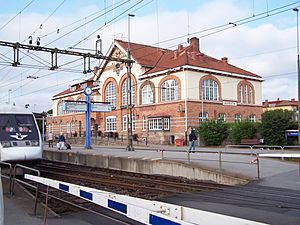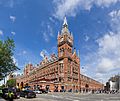Train station facts for kids

A train station is a special place where people get on and off trains. Sometimes, goods are also loaded or unloaded here. In the past, most stations handled both people and goods. Now, goods are usually only handled at very large stations.
Train stations are always built next to a railway line. Some stations are at the very end of a train route; these are called terminus stations. Most stations have platforms which are raised areas that make it easy and safe for passengers to get on and off the train. Many stations also have useful things like shelters, places to buy tickets, and benches to sit on.
The busiest train station in the world is Shinjuku Station in Tokyo, Japan. The largest station is Nagoya Station in Nagoya, Japan. In Europe, the busiest station is Clapham Junction in south London, United Kingdom. During busy times, a train arrives or leaves there every 13 seconds!
Different Kinds of Train Stations
-
Luxulyan railway station in Cornwall, a very simple train station. Trains only stop here if someone asks them to. About 1,000 people use this station each year.
-
A terminus station in Paris. Trains that go through here must change direction. But people can walk easily from one track to another.
-
Shinjuku Station in Tokyo is the busiest train station in the world. About 3.6 million people use it every day. This picture shows what it looks like during rush hour.
-
Platforms at Leeds City Station in Leeds, UK.
What You Can Find at a Station
Train stations usually have places to buy tickets. These can be ticket booths with a person helping you, or ticket machines where you buy tickets yourself. Sometimes, ticket sales are combined with an information desk or a small shop. Many stations also have a shop or a kiosk where you can buy snacks or newspapers.
Bigger stations often have places to get fast-food or even restaurants. In some countries, these larger stations might also have a bar or a pub. Other things you might find at a train station include:
- toilets
- Rooms to store your luggage
- A lost-and-found office for things people have left behind
- Timetables showing when trains arrive and leave
- trolleys to help carry your bags
- waiting rooms
- Places for taxis to pick up passengers
- bus stops for connecting journeys
Images for kids
-
Station with train and coal depot by Gustave Le Gray, (around 1850–1860s)
-
A Presto contactless smart card reader and self-serve ticket machine at a suburban train station in Toronto.
-
Grand Central Terminal in New York City has the most platforms, with 44 on two levels.
-
St Pancras station in London, designed by William Henry Barlow and opened in 1868.
-
Amsterdam Centraal station in Amsterdam, Netherlands.
-
Berlin Hauptbahnhof in Berlin, Germany.
-
Helsinki Central Station, designed by Eliel Saarinen, is in the city center of Helsinki, the capital of Finland.
-
Luz Station in São Paulo, Brazil. Since 2006, it is also home to the Museum of the Portuguese Language.
-
Dunedin Railway Station in Dunedin, New Zealand, is one of the country's most famous old buildings.
-
Hsinchu Station in Hsinchu City, Taiwan.
-
The central station of Utrecht, Netherlands.
See also
 In Spanish: Estación de ferrocarril para niños
In Spanish: Estación de ferrocarril para niños



















